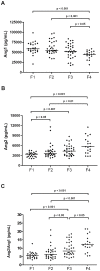Angiopoietin-2 Serum Levels Improve Noninvasive Fibrosis Staging in Chronic Hepatitis C: A Fibrogenic-Angiogenic Link
- PMID: 23823085
- PMCID: PMC3688858
- DOI: 10.1371/journal.pone.0066143
Angiopoietin-2 Serum Levels Improve Noninvasive Fibrosis Staging in Chronic Hepatitis C: A Fibrogenic-Angiogenic Link
Abstract
Aims: Accurate liver fibrosis staging is crucial for the management of chronic hepatitis C (CHC). The invasiveness and cost burden of liver biopsy have driven the search for new noninvasive biomarkers of fibrosis. Based on the link between serum angiopoietin-1 and 2 levels and CHC progression, we aimed to determine the value of these angiogenic factors as noninvasive biomarkers of liver fibrosis.
Methods: Serum levels of angiopoietin-1 and -2 were measured by ELISA in 108 CHC patients who underwent pretreatment liver biopsy. The correlation between angiopoietins and clinical and demographic variables with liver fibrosis was analyzed by univariate regression. Significant factors were then subjected to multivariate analysis, from which we constructed a novel noninvasive liver fibrosis index (AngioScore), whose performance was validated in an independent series of 71 CHC patients. The accuracy of this model was compared with other documented fibrosis algorithms by De Long test.
Results: Angiopoietins correlated significantly with hepatic fibrosis; however, only angiopoietin-2 was retained in the final model, which also included age, platelets, AST, INR, and GGT. The model was validated and behaved considerably better than other fibrosis indices in discriminating all, significant, moderate and severe liver fibrosis (0.886, 0.920, 0.923). Using clinically relevant cutoffs, we classified CHC patients by discarding significant fibrosis and diagnosing moderate and severe fibrosis with greater accuracy, sensitivity, and specificity.
Conclusions: Our novel noninvasive liver fibrosis model, based on serum angiopoietin-2 levels, outperforms other indices and should help substantially in managing CHC and monitoring long-term follow-up prognosis.
Conflict of interest statement
Figures



Similar articles
-
Angiopoietin-2/angiopoietin-1 as non-invasive biomarker of cirrhosis in chronic hepatitis C.World J Gastroenterol. 2016 Nov 28;22(44):9744-9751. doi: 10.3748/wjg.v22.i44.9744. World J Gastroenterol. 2016. PMID: 27956798 Free PMC article.
-
Noninvasive estimation of liver fibrosis in biopsy-proven hepatitis C virus-infected patients: angiogenic fibrogenic link.Eur J Gastroenterol Hepatol. 2017 Feb;29(2):199-207. doi: 10.1097/MEG.0000000000000775. Eur J Gastroenterol Hepatol. 2017. PMID: 27930387
-
Evaluating Diagnostic Accuracy of Noninvasive Tests in Assessment of Significant Liver Fibrosis in Chronic Hepatitis C Egyptian Patients.Viral Immunol. 2018 May;31(4):315-320. doi: 10.1089/vim.2017.0134. Epub 2018 Apr 9. Viral Immunol. 2018. PMID: 29630460
-
Noninvasive diagnosis of hepatic fibrosis in chronic hepatitis C.World J Gastroenterol. 2007 Aug 28;13(32):4287-94. doi: 10.3748/wjg.v13.i32.4287. World J Gastroenterol. 2007. PMID: 17708599 Free PMC article. Review.
-
Performance of the aspartate aminotransferase-to-platelet ratio index for the staging of hepatitis C-related fibrosis: an updated meta-analysis.Hepatology. 2011 Mar;53(3):726-36. doi: 10.1002/hep.24105. Epub 2011 Feb 11. Hepatology. 2011. PMID: 21319189 Review.
Cited by
-
Therapeutic targeting of the angiopoietin-TIE pathway.Nat Rev Drug Discov. 2017 Sep;16(9):635-661. doi: 10.1038/nrd.2016.278. Epub 2017 May 19. Nat Rev Drug Discov. 2017. PMID: 28529319 Review.
-
Angiopoietin-2/angiopoietin-1 as non-invasive biomarker of cirrhosis in chronic hepatitis C.World J Gastroenterol. 2016 Nov 28;22(44):9744-9751. doi: 10.3748/wjg.v22.i44.9744. World J Gastroenterol. 2016. PMID: 27956798 Free PMC article.
-
Angiopoietin-2 levels correlates with disease activity in children with nonalcoholic fatty liver disease.Pediatr Res. 2022 Jun;91(7):1781-1786. doi: 10.1038/s41390-021-01666-5. Epub 2021 Jul 30. Pediatr Res. 2022. PMID: 34331020
-
Serum Angiopoietin-2 Predicts Mortality and Kidney Outcomes in Decompensated Cirrhosis.Hepatology. 2019 Feb;69(2):729-741. doi: 10.1002/hep.30230. Epub 2019 Jan 4. Hepatology. 2019. PMID: 30141205 Free PMC article.
-
Inhibition of tyrosine kinase receptor Tie2 reverts HCV-induced hepatic stellate cell activation.PLoS One. 2014 Oct 10;9(10):e106958. doi: 10.1371/journal.pone.0106958. eCollection 2014. PLoS One. 2014. PMID: 25302785 Free PMC article.
References
-
- Seeff LB (2002) Natural history of chronic hepatitis C. Hepatology. 36: S35–46. - PubMed
-
- European Association for the Study of the Liver (2011) EASL Clinical Practice Guidelines: management of hepatitis C virus infection. J Hepatol 55: 245–264. - PubMed
-
- Bedossa P, Dargere D, Paradis V (2003) Sampling variability of liver fibrosis in chronic hepatitis C. Hepatology. 38: 1449–1457. - PubMed
Publication types
MeSH terms
Substances
LinkOut - more resources
Full Text Sources
Other Literature Sources
Medical
Miscellaneous

